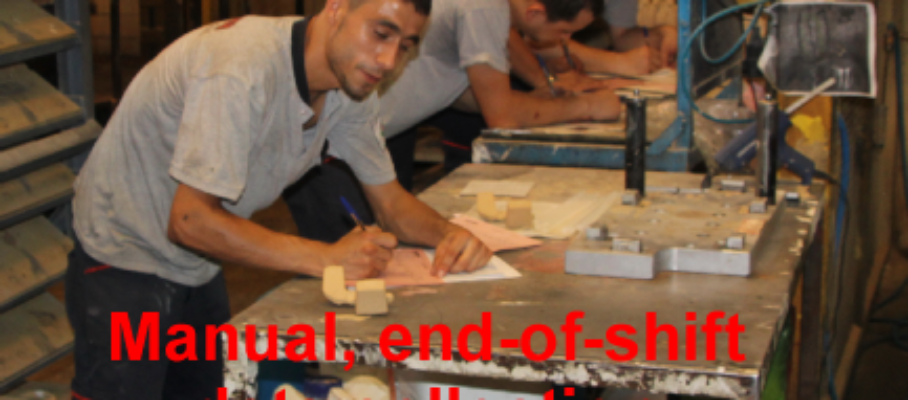Jul 5 2012
Using iPads, QR scans, Sharepoint and Infopath to implement TWI
Franck Vermet‘s group at Schlumberger in Rosharon, TX, assembles and tests measurement instruments that operate deep inside oil wells. They are built for internal use by Schlumberger Oilfield Services, to collect data for customers. They are high-value products, with tight tolerances and the ability to operate in an environment that is not friendly to electronics.
With Mark Warren‘s help, Vermet’s group has been looking to TWI as a way to rely less on knowledge in the heads of experienced operators and more on documented processes for the following purposes:
- To ensure that the same work is done the same way by different individuals.
- To train new operators faster.
- To improve the processes systematically and in a controlled manner.
- To support the implementation engineering changes to the products and new product introduction.
In World War II, however, TWI was implemented with cardboard pocket cards and handwritten Job Breakdown sheets, but the Schlumberger team was determined to use more modern technology. After investigating the available options, they realized the following:
- Sharepoint has a built-in revision management system that makes a Sharepoint site suitable as a repository of process specifications. This helps with traceability and ISO compliance.
- Infopath is a form design tool they could use to generate TWI templates and store the filled out Job Breakdown sheets in the Sharepoint site.
- iPads are an effective presentation device on the shop floor, not just for the equivalent of pocket cards, but for drawings and photographs as well.
- QR scans linking to job instructions are posted on equipment by means of printed magnets. They can be scanned using an iPad to retrieve the instructions from the Sharepoint site.
Implementation is still in its early days, but all indications from users are that it works. It should be noted also that the approach is sound from the point of view of data management. Unlike the proliferation of Excel spreadsheets that is so often seen in factories, with more or less accurate and up-to-date copies of master data floating around, this approach provides the necessary controls, with the current data retrieved from the server as needed.
As could be expected, the Schlumberger team is facing headwinds from two directions:
- Among the TWI revivalists, there are those for whom, if it’s not handwritten on cardboard, it isn’t TWI, and they frown on the use of a gadget like the iPad. Never mind that many retail shops already use them as point-of-sale systems.
- Within the company, TWI-authenticity is nor a concern, but the uncontrolled spread of computer and networking technology is, at least for the IT department. It supports the use of a standard configuration of tools, which does not include what Vermet’s group is using.
The Schlumberger team is now training suppliers in these tools with the goal of getting them to inspect outgoing parts in such a way that incoming inspection at Schlumberger can be eliminated.





Dec 3 2012
Lean IT Summit 2012 – Were the presentations on topic?
See on Scoop.it – lean manufacturing

What does “Lean IT” mean? Most of those who use this term think of it as the application of Lean principles to the operations of IT companies or departments. To others, including myself, it is primarily about the effective use of IT in support of Lean manufacturing, which is a completely different but very real problems.
The IT departments of manufacturing companies are rarely any help in implementing Lean. The plants’ information systems are full of data about the business and the technology of the plant that is only accessible through the IT department, but its members are busy implementing system upgrades and have no clue what uses this data could be put to.
On the other side are Lean implementers whose computer skills are limited to Excel and PowerPoint, and who underestimate the potential of 21st century IT based on comments made by Ohno in the 1960s.
I looked in vain for any discussion of these issues in the presentations at this summit, although plenty of solutions exist. There could have been, for example, discussions of how data warehousing technology to consolidate data from multiple legacy system into a single, comprehensive source of clean data about product and process specs, the status and history of demand and production, quality, maintenance, inventory, and the supply chain, along with plans for the future.Then it would have been fascinating to hear how tools like the ones Nate Silver applied to US presidential politics could be applied to identifying patterns in this data could be used to allocate products among families and size production lines for each family…
We could also have heard about Lean implementers breaking out of the Excel/PowerPoint box, learning how to design and query databases, and how to judiciously apply data mining tools.
This is about making IT effective, and it should be job one. Then we can worry about applying Lean internally to IT department to make them more efficient.
See on www.lean-it-summit.com
Share this:
Like this:
By Michel Baudin • Blog clippings 0 • Tags: Information technology, IT, Lean IT, Lean manufacturing